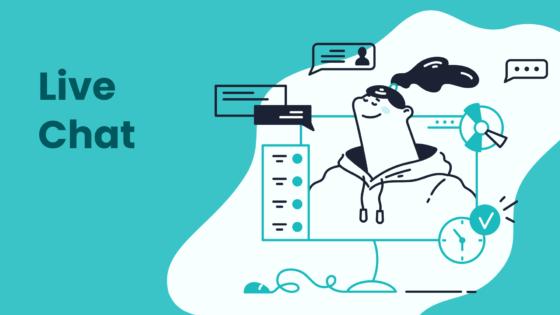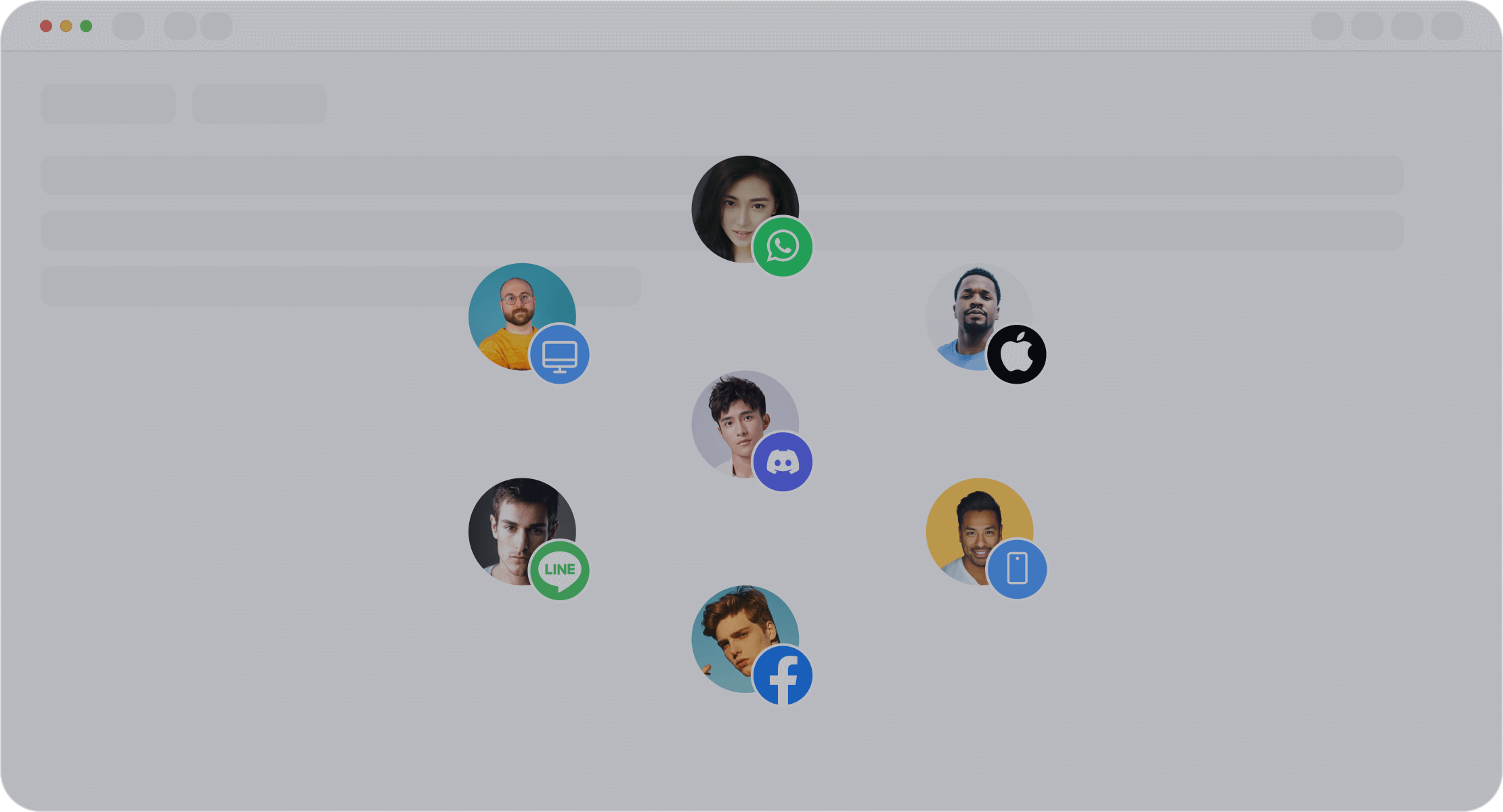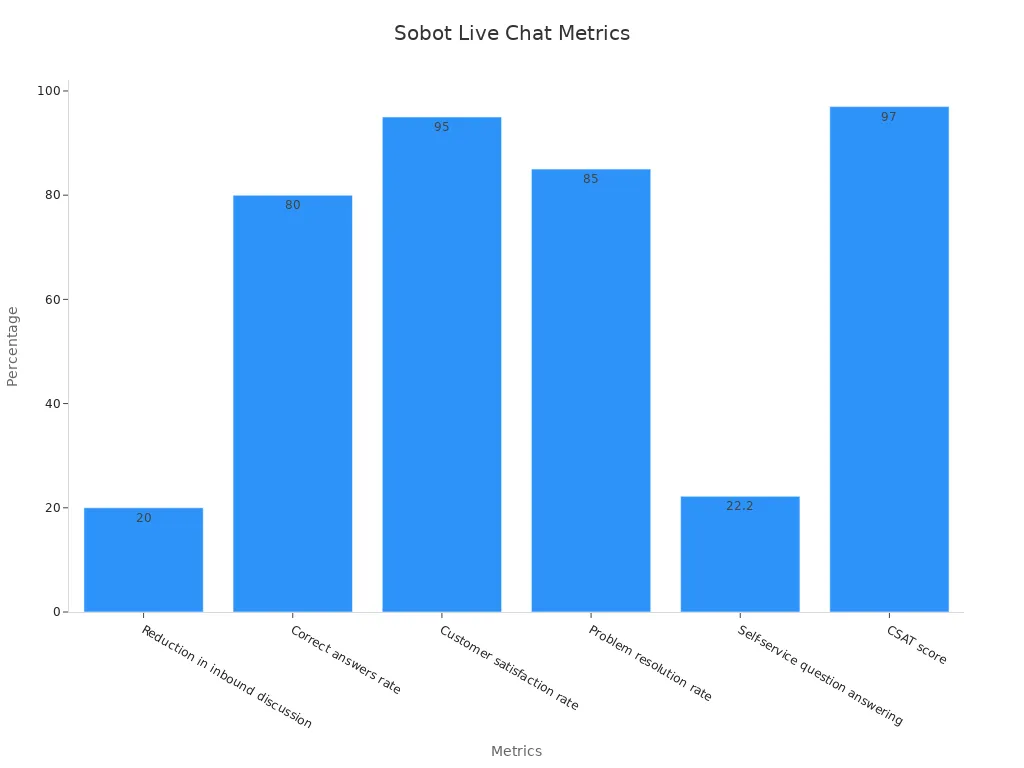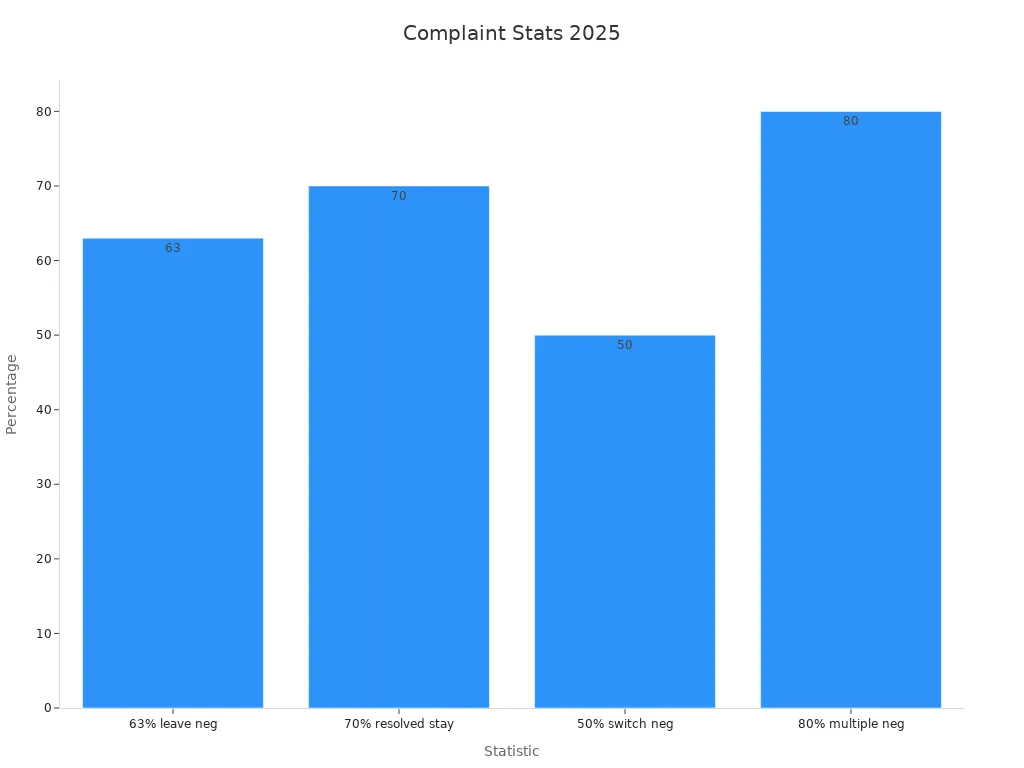How to Handle Customer Complaints Effectively in 2025

In 2025, handling customer complaints effectively isn’t just a good practice—it’s a necessity. Customers expect fast, personalized responses, and their loyalty hinges on how well you address their concerns. Did you know that 91% of unhappy customers who don’t voice their complaints simply walk away? That’s a staggering figure, but here’s the good news: resolving issues quickly can turn things around. Customers whose problems are solved in under five minutes are likely to spend more with your business in the future.
The stakes are high. Businesses lose $75 billion annually due to poor customer service, and even brands with loyal followers aren’t immune. For instance, 32% of customers would stop supporting a favorite brand after just one bad experience. But when you manage complaints effectively, the rewards are immense. Companies that retain 5% more of their customers see a 25% boost in profits. Tools like Sobot’s Live Chat can help you respond faster and smarter, offering a seamless customer complaint response example that builds trust and drives growth.
Understanding Customer Complaints

What Are Customer Complaints?
Customer complaints are expressions of dissatisfaction when something doesn’t meet expectations. These could be about a product, service, or even the way a business communicates. For example, a delayed delivery or a confusing return policy might frustrate customers. Complaints aren’t just problems—they’re opportunities. When customers take the time to share their concerns, they’re giving you a chance to improve.
A recent study involving over 200 brands and 1,000 customers revealed that businesses often underestimate the frequency of poor customer experiences by 38%. This means many companies miss out on valuable insights that could help them grow.
Why Do Customer Complaints Matter for Businesses?
Customer complaints matter because they directly impact your bottom line. When you address concerns effectively, you can turn unhappy customers into loyal ones. Did you know that a 5% increase in customer retention can boost profits by 25% to 95%? That’s a huge payoff for simply listening and responding to feedback.
On the flip side, ignoring complaints can be costly. Poor customer experiences risk losing $1.9 trillion in consumer spending annually in the U.S. alone. By taking complaints seriously, you’re not just solving problems—you’re protecting your revenue and reputation.
The Role of Customer Feedback in Business Success
Customer feedback is like a roadmap for your business. It shows you what’s working and what needs fixing. Companies that excel in customer experience often see revenue growth that’s double that of their competitors. Plus, customers with the best experiences spend 140% more than those with the worst.
Improving customer satisfaction also boosts retention. When customers feel heard, they’re more likely to stick around. In fact, a 5% increase in retention can lead to significant profit growth. Listening to feedback isn’t just good practice—it’s essential for long-term success.
Common Complaints and Their Impact on Customer Service
Examples of Common Complaints in 2025
In 2025, customer expectations have reached new heights, and businesses face recurring complaints that can’t be ignored. Here are some of the most common complaints reported:
- SaaS Product Improvement: Customers often express frustrations over confusing user interfaces, leading to high abandonment rates during onboarding. Companies addressing this issue have seen a 30% increase in onboarding completion rates.
- E-commerce Customer Experience: Shoppers frequently complain about cumbersome checkout processes, which result in abandoned carts. Redesigning these processes has reduced cart abandonment rates by 25%.
- Support Challenges: Long wait times remain a top concern, with 52% of consumers citing it as a negative factor. Additionally, 50% of customers dislike repeating their issues multiple times.
These complaints highlight the importance of listening to feedback and taking action. Ignoring them can lead to negative feedback and lost opportunities for customer retention.
The Role of Empathy in Addressing Complaints
Empathy is the cornerstone of excellent customer service. When you practice reflective listening, you show customers that their concerns matter. For example, if a customer complains about a delayed delivery, acknowledging their frustration and offering a solution can turn a negative experience into a positive one.
Reflective listening involves repeating or paraphrasing what the customer says to confirm understanding. This approach not only diffuses tension but also builds trust. Customers who feel heard are more likely to remain loyal, even after a bad experience. Empathy isn’t just about solving problems—it’s about creating connections that foster long-term customer retention.

How Sobot Live Chat Can Help Resolve Common Complaints
Sobot Live Chat is a game-changer when it comes to addressing common complaints. Its features are designed to tackle frustrations like long wait times and repetitive explanations. With omnichannel support, customers can reach you on their preferred platform, ensuring no interaction is missed.
The platform’s AI-powered tools streamline responses, reducing inbound discussions by 20% and achieving a 95% customer satisfaction rate. Its unified workspace allows agents to access customer data instantly, enabling faster resolutions. Here’s a snapshot of its performance metrics:
| Metric | Value |
|---|---|
| Reduction in inbound discussion | 20% |
| Positive feedback rate | 96%+ |
| Correct answers rate | 80% |
| Customer satisfaction rate | 95% |
| Problem resolution rate | 85% |
| Self-service question answering | 22.2% |
| CSAT score | 97% |

By integrating Sobot Live Chat, you can address complaints efficiently, reduce negative feedback, and enhance customer retention. It’s not just a tool—it’s a solution that transforms how you handle customer service.
The Cost of Unresolved Customer Complaints
Financial Implications for Businesses
Unresolved complaints can hit your business where it hurts the most—your wallet. When customers feel ignored, they’re less likely to return, and that means lost revenue. Studies show that businesses lose billions annually due to poor customer service. For example, in ecommerce customer service, a single unresolved issue can lead to abandoned carts or canceled subscriptions.
Think about it: every complaint you don’t address is a missed opportunity to retain a customer. And retaining customers is far more cost-effective than acquiring new ones. By resolving complaints quickly, you not only save money but also create loyal customers who are more likely to recommend your brand to others.
Damage to Brand Reputation
Your reputation is everything. When complaints go unresolved, it doesn’t just frustrate customers—it tarnishes your brand image. In ecommerce customer service, delays, lack of personalization, and human errors can make customers feel undervalued. Here’s a breakdown of how these challenges impact your reputation:
| Challenge | Impact on Brand Reputation |
|---|---|
| Delays and long response times | Worsens customer dissatisfaction |
| Lack of personalization | Customers feel ignored or undervalued |
| Human errors | Misinterpretation and loss of information |
| High costs | Leads to inefficient resource utilization |
| Scalability issues | Overwhelms response capability, impacting efficiency |
When customers share their negative experiences online, it can spread like wildfire. A single bad review can deter potential customers, making it harder for you to compete in a crowded market. Addressing complaints promptly helps you maintain a positive image and stand out from competitors.
Loss of Customer Trust and Loyalty
Trust is hard to earn but easy to lose. When complaints go unresolved, customers feel let down. In ecommerce customer service, this often happens when self-service options fail to resolve issues, forcing customers to escalate their concerns. Here’s what the data shows:
| Statistic | Description |
|---|---|
| 14% | Only 14% of customer service issues are fully resolved through self-service channels. |
| 73% | 73% of customers start their service journey in self-service but often escalate to live support due to unresolved issues. |
| 36% | Resolution rates for simple issues are only 36%. |
Unresolved complaints lead to frustration, eroding trust and increasing the likelihood of churn. Customers who feel ignored are more likely to switch to competitors, leaving you with higher acquisition costs and lower retention rates. By addressing complaints effectively, you can rebuild trust and foster long-term loyalty.
Strategies to Handle Customer Complaints Effectively
Customer Complaint Response Example: Best Practices
Responding to complaints effectively starts with understanding what works. A great customer complaint response example includes three key steps: acknowledge frustrations, propose a solution, and follow up with the customer. Let’s break it down:
- Acknowledge frustrations: Start by showing empathy. For instance, if a customer complains about a delayed order, say, “We understand how frustrating this delay must be for you.” This simple step builds trust.
- Propose a solution: Offer a clear and actionable resolution. If a product is defective, provide a replacement or refund. Setting realistic expectations about timelines is crucial here.
- Follow up with the customer: After resolving the issue, check back to ensure satisfaction. A quick email or call can make a lasting impression.
Here’s how these best practices translate into measurable success:
| Metric | Description | Calculation Method |
|---|---|---|
| Overall resolution rate | Measures how many issues are resolved successfully. | (Total number of tickets / number of tickets solved) |
| First contact resolution rate | Tracks efficiency by showing how many cases are resolved on the first contact. | (Number of incidents resolved on first contact / total number of incidents) |
| Average ticket handling time | Reflects how quickly agents resolve issues while maintaining quality. | Average time spent per ticket over a defined period |
By following these steps, you can handle customer complaints effectively and turn negative experiences into positive ones.
Leveraging Sobot Live Chat for Faster Resolutions
Sobot Live Chat is a powerful tool for resolving customer complaints quickly. Its omnichannel support ensures customers can reach you on their preferred platform, whether it’s WhatsApp, Instagram, or your website. This eliminates the frustration caused by a lack of communication.
The platform’s AI-powered tools streamline problem resolution by automating repetitive tasks. For example, its intelligent assignment feature directs complaints to the right agent instantly. This reduces unresolved issues and improves efficiency. Additionally, Sobot Live Chat’s built-in analytics helps you track customer complaints and identify patterns, enabling proactive improvements.
With Sobot Live Chat, you can set realistic expectations for response times and deliver resolutions faster. Its unified workspace ensures agents have all the information they need, reducing average ticket handling time. This not only boosts customer satisfaction but also strengthens loyalty.
Training Customer Support Teams for Success
Your team is your greatest asset in customer service. Training them effectively ensures they’re equipped to handle customer complaints with confidence. Start by identifying gaps and needs. Use metrics like satisfaction scores to pinpoint areas for improvement.
Tailor training content to address specific challenges. For example, if agents struggle with first contact resolution, focus on improving communication skills and problem-solving techniques. Measuring effectiveness is equally important. Combine quantitative metrics with qualitative feedback to assess progress and refine your approach.
Investing in training doesn’t just improve service quality—it also boosts morale. When your team feels supported, they’re more likely to deliver exceptional service. This creates a ripple effect, enhancing customer satisfaction and loyalty.
Establishing Clear Communication Channels
Clear communication channels are the backbone of effective customer service. When customers know how to reach you and receive timely responses, their trust in your brand grows. But how do you ensure your communication channels are up to par? Start by offering multiple options—email, live chat, social media, and even phone support. This way, customers can choose what works best for them.
A recent survey highlights why this matters:
- 75% of customers believe fast response times reflect how customer-friendly a brand is.
- Nearly half (46%) expect a response in under four hours.
- An overwhelming 90% consider instant replies crucial when seeking assistance.
Sobot Live Chat is a perfect example of how technology can streamline communication. With omnichannel support, it lets customers connect through their preferred platforms, whether it’s WhatsApp, Instagram, or your website. Its AI-powered tools ensure quick responses, reducing wait times and improving satisfaction. By integrating such tools, you can meet customer expectations and build stronger relationships.
Proactively Seeking Customer Feedback
Waiting for customers to complain isn’t enough. You need to actively seek their input to understand what’s working and what isn’t. Regular surveys, feedback forms, and even casual conversations can reveal valuable insights. For instance, asking customers about their experience with your service can uncover areas for improvement.
Here’s what research shows about the benefits of proactive feedback:
| Finding | Description |
|---|---|
| Lack of CFAT | Many businesses miss opportunities to improve due to a lack of feedback triggers. |
| Influence of Active Feedback | Actively collecting feedback enhances service quality and operational efficiency. |
| Importance of Personalized Feedback | Personalized feedback provides deeper insights compared to generic surveys. |
By using tools like Sobot Live Chat, you can make feedback collection seamless. Features like satisfaction surveys and built-in analytics help you gather and analyze data effortlessly. This not only improves service quality but also strengthens customer loyalty. Remember, when customers feel heard, they’re more likely to stick around.
Building a Customer-Centric Culture

Aligning Business Goals with Customer Needs
To build a customer-centric culture, you need to align your business goals with what your customers truly want. This means actively listening to their feedback and using it to shape your strategies. For example, if customers frequently mention long wait times, reducing response times should become a priority.
Here’s how aligning goals with customer needs can drive results:
| Example | Goal | Expected Improvement |
|---|---|---|
| Telecom Provider | Reduce customer service response times | 50% within six months |
| Healthcare Organization | Improve patient experience scores | 20% based on feedback |
When you focus on what matters most to your customers, you create a win-win situation. They feel valued, and your business thrives. Research shows that companies with a customer-centric culture are 60% more profitable and outperform competitors by 62%.
Encouraging Continuous Improvement in Customer Service
Customer service isn’t a one-and-done effort. It’s an ongoing process that requires constant refinement. Start by listening to your team and customers. What are they saying about your service? Use this feedback to identify areas for improvement.
Metrics like Customer Satisfaction Score (CSAT) and Net Promoter Score (NPS) can help you track progress. Here’s a quick look at some key metrics:
| Metric | Description |
|---|---|
| Customer Satisfaction Score (CSAT) | Measures customer satisfaction with goods or services, providing insights into strengths and weaknesses. |
| Customer Effort Score (CES) | Assesses how easy it is for customers to interact with a business, highlighting friction points. |
| Net Promoter Score (NPS) | Evaluates customer loyalty and likelihood to recommend, indicating overall sentiment and growth potential. |
By focusing on continuous improvement, you not only enhance the customer experience but also boost team morale. A motivated team delivers better service, creating a cycle of success.
Measuring Success Through Customer Satisfaction Metrics
How do you know if your efforts are paying off? By measuring success through customer satisfaction metrics. These metrics give you a clear picture of what’s working and what needs attention.
For instance, NPS helps you identify loyal customers who are likely to recommend your brand. CSAT provides immediate feedback on specific interactions, while CES highlights areas where customers face challenges.
| Metric | Purpose | Key Insight |
|---|---|---|
| NPS | Long-term strategy | Helps identify brand advocates and overall customer loyalty. |
| CSAT | Specific touchpoints | Provides immediate feedback on customer satisfaction for individual interactions. |
| CES | Process optimization | Measures ease of interaction, helping to reduce friction in customer journeys. |
Tracking these metrics regularly ensures you stay on top of customer needs. It also helps you make data-driven decisions that improve both customer satisfaction and business performance.
The Role of Technology in Fostering Customer Loyalty
Technology plays a huge role in keeping customers loyal to your brand. It’s not just about offering great products anymore—it’s about creating personalized experiences that make customers feel valued. With tools like AI, data analytics, and machine learning, you can understand your customers better and give them exactly what they want.
Here’s how technology helps you build loyalty:
- Personalized experiences: AI and data analytics let you tailor interactions based on customer behavior. For example, you can recommend products they’re likely to love or send them offers that match their preferences.
- Smarter loyalty programs: Machine learning helps you design programs that reward customers in ways they’ll appreciate. Gamification elements, like earning points or unlocking badges, make these programs fun and engaging.
- Better segmentation: Data analytics lets you group customers based on how they shop or interact with your brand. This helps you focus on premium customers and offer them exclusive perks.
Imagine this: a customer visits your website, and instead of generic suggestions, they see products that match their past purchases. They also get a personalized discount for being a loyal shopper. That’s the power of technology—it makes every interaction feel special.
Regularly updating your loyalty programs based on data keeps them fresh and relevant. Customers notice when you adapt to their changing needs, and that builds trust. When you use technology to create meaningful connections, you’re not just earning loyalty—you’re building relationships that last.
Addressing customer complaints effectively in 2025 isn’t just about solving problems—it’s about building trust and loyalty. When you handle complaints proactively, you show customers that their concerns matter. This approach not only strengthens relationships but also drives business growth.
Consider this: 70% of unhappy customers are more likely to stay if their complaints are resolved. On the flip side, 63% will leave after just one bad experience. Effective complaint management is your best solution to retain customers and protect your reputation.
| Statistic | Impact on Customer Behavior |
|---|---|
| 63% of customers are more likely to leave after a single negative experience | Highlights the risk of losing customers due to poor complaint handling |
| 70% of unhappy customers whose complaints are resolved are more likely to stay | Indicates the positive effect of effective complaint resolution on loyalty |
| 50% of customers switch to competitors after one negative experience | Emphasizes the importance of addressing complaints promptly |
| 80% of customers will switch after multiple negative experiences | Reinforces the need for effective complaint management to retain customers |

Proactive complaint management also boosts key performance indicators like Customer Satisfaction (CSAT) and Net Promoter Score (NPS). A high NPS, for example, correlates with business growth and customer loyalty. By adopting a customer-centric culture and leveraging tools like Sobot’s omnichannel solution, you can meet evolving expectations and stay competitive in today’s market.
| KPI | Description | Benchmark/Goal |
|---|---|---|
| Customer Satisfaction (CSAT) | Measures customer happiness with support experience on a scale. | Aim for 85-90% |
| Net Promoter Score (NPS) | Measures likelihood to recommend on a scale. High NPS correlates with growth. | 50+ is considered excellent |
| Customer Effort Score (CES) | Rates perceived effort in issue resolution. Lower effort leads to loyalty. | Benchmark over 4 |
| Repeat Contact Rate | Percentage of customers needing to contact again about unresolved issues. | Aim for under 10% |
| First Contact Resolution (FCR) | Percentage of queries resolved in one interaction. Higher FCR improves experience. | Higher is better |
| Average Resolution Time | Average time taken to resolve issues. Faster resolution is preferred. | Lower is better |
In 2025, the right solution isn’t just about technology—it’s about creating meaningful connections. By listening to your customers, addressing their concerns, and using tools like Sobot’s omnichannel solution, you can turn complaints into opportunities. This strategy doesn’t just help you grow—it ensures your customers grow with you.
FAQ
What is the best way to respond to customer complaints?
The best way is to listen actively, show empathy, and offer a solution quickly. Acknowledge the issue, apologize if needed, and explain the steps you’ll take to fix it. Tools like Sobot Live Chat can help streamline your customer support process for faster resolutions.
How can technology improve customer support in 2025?
Technology like AI and automation makes customer support faster and more efficient. For example, Sobot Live Chat uses AI to route complaints to the right agent and provide instant responses. This reduces wait times and improves customer satisfaction, helping you build stronger relationships.
Why is empathy important in customer support?
Empathy shows customers you care about their concerns. When you acknowledge their feelings and frustrations, it builds trust. Customers who feel heard are more likely to stay loyal, even after a bad experience. Empathy turns complaints into opportunities to strengthen relationships.
How does Sobot Live Chat help with customer complaints?
Sobot Live Chat simplifies customer support by unifying all communication channels. It uses AI to automate repetitive tasks and provides agents with customer data for personalized service. This reduces response times and ensures complaints are resolved efficiently, improving customer satisfaction.
What are the benefits of proactive customer feedback?
Proactively seeking feedback helps you identify issues before they escalate. It shows customers you value their opinions, which builds trust. Tools like Sobot Live Chat make it easy to collect feedback through surveys, helping you improve your service and retain loyal customers.
See Also
Enhancing Customer Satisfaction Through Effective Live Chat Strategies
Essential Practices for Optimizing Call Center Quality Management
2024 Review of Leading Contact Center Solutions Available
A Guide to Successfully Implementing Omnichannel Contact Centers
